Exploring the intersection of spaceflight history, pop culture, and space art.
In the previous Creating Space post, I introduced readers to a children’s book that inspired my latest Lunar Module rendering. This time, I take you inside the book, with a focus on the illustrations, to explore the Apollo lunar mission events and perhaps learn some things along the way.
Are you new to Creating Space? It’s the NERDSletter that explores the intersection of spaceflight history, pop culture, and space art. You can find this and all other posts at creating-space.art.
Book of the Month
Moonshot 1970
Moonshot 1970 – The true story of America’s Astronauts; from blast-off, to lunar touchdown, to ocean recovery, by Martha Lomask, illustrated by Gordon Mellor, For Children, Inc. Columbus, Ohio, © 1967
“Flight plan for America’s astronauts going to the moon is nicknamed L.O.R. (Lunar Orbit Rendezvous). L.O.R. is a roadmap through space to the moon. This book begins at Cape Kennedy – sometime in 1970. It describes our first manned Moonshot and what you would be doing if you were aboard.”
As a kid growing up in the 1960s, the Apollo program was of great fascination to me. I devoured any articles with detailed descriptions, photos, and illustrations of the Saturn V rocket, Command and Service Modules, and especially the Lunar Module. Equally as interesting to me was the Apollo mission profile to the Moon and back. Pinned on the wall above my bed was the government issued 4-foot long glossy poster of the path of the Apollo spacecraft. I spend countless hours standing on my bed studying every detail of that poster, including the tiny illustrations of the spacecraft in their various configurations on the way to the Moon and back to splashdown in the Pacific Ocean. I would imagine myself going along for the ride.

Profile in Pictures
The book, Moonshot 1970, is essentially a narrative and picture form of the Apollo mission profile poster. The book’s subtitle says it all – “The true story of America’s Astronauts; from blast-off, to lunar touchdown, to ocean recovery.” The first page launches right into the details by teaching the young reader the name chosen for how NASA would get to the Moon – Lunar Orbit Rendezvous, or L.O.R.
The Apollo lunar mission profile lends itself perfectly to book format for young readers. Each step in the flight practically writes itself onto their respective pages. The highly complex vehicles literally break down into separate parts – falling off or being jettisoned along the way. By the time the last page is turned, the spacecraft parts and functions, and the maneuvers they make to complete their tasks, are thoroughly understood.
Let’s Do Launch
As the reader, you are brought along for the ride. This imagined level of participation was common in children’s books of the time. For instance, the last sentence on this page describing the launch says, “We are going to the moon, and our trip opens the universe to men.”
Stages to Orbit
The first two illustrations within the book are rather simple in style. Now, turning the page reveals a slightly more realistic rendering. The view is from high above the Earth where, using a multiple exposure effect, we witness the sequence of stagings of the mighty Saturn V booster.
It is a beautiful rendition for a children’s book, and the multiple exposure effect is a clever way to show the succession of events in a single image. But, I have a suspicion the illustrator, Gordon Mellor, has a little secret that I am about to reveal.
As we will see throughout this article, several of the illustrations apparently trace their origins to more refined paintings created by noted space artist, Pierre Mion. In the 1960s, Mion created beautiful renditions of space vehicles for National Geographic and LOOK magazines, among others. Anyone alive during that time who had any interest in spaceflight and artwork would surely recognize his work. And, like me, they would likely find great inspiration in the images and the stories that were published with them.
One such magazine that featured Pierre Mion’s illustrations was the March 1964 issue of National Geographic.
Within its glossy pages were a series of illustrations that, just as in Moonshot 1970, showed the reader the important steps planned for the upcoming Apollo lunar missions. Topping a three-page fold-out of five paintings is one that depicts the first six key events after an Apollo launch – each shown in close succession across the pages.
It seems clear to me that the Moonshot 1970 artist has lifted the first three post-launch steps straight from Mion’s painting. Not that there’s anything wrong with that, as the saying goes. Given any assignment, working artists must use references where they can find them. In the case of illustrating a space mission and vehicles that had yet to be flown, one can be excused for going to the best available authorities for their references. In this case, that source was likely the prestigious National Geographic Magazine with its stellar illustrations by Pierre Mion.
We will see more examples of this as we turn the pages.
Shrouded in History
Next in the book, we are presented with a cutaway illustration of the upper stage of the Saturn V containing the Apollo spacecraft. Interestingly, the Service Module seems to be contained within an exterior shroud, similar to how the Lunar Module is nestled within the Spacecraft Lunar Module Adapter (SLA).
Space Walking
The Command Module cutaway shows just how roomy – or cramped, depending on your point of view – the crew compartment is. I find it interesting that they describe the cabin as having room “for one astronaut to walk around, while the other two work with instruments, talk to earth, or take a nap.” I’m not sure how much walking would be happening in zero-G.
I am reminded of a now classic meme which states, “When building a spaceship, the tiniest details are crucial. For example, this spaceship may be flawed because it has a giant hole in the side.”
A Peeling Spacecraft
Now that we are familiar with the spacecraft, we return to the mission sequence of events. It is time for Transposition and Docking, though the maneuver is not described in those terms. Instead, we are told that “using complex instruments and careful timing the astronauts will ‘peel’ L.E.M. from its protective casing at the rear of Apollo.”
Here, again, are two more of the mission events that appear to be copied from Pierre Mion’s National Geographic illustration, right down to the paint scheme on the rocket stage.
LEM Extraction
The next image is one of the more beautiful illustrations contained in the book, in my view. What would actually be the inky blackness of space has been depicted in bright blue nebulous swirls mixed with clusters of bright white stars.
This one, again, seems to emulate Pierre Mion’s rendition. But, I think in this case Mellor has improved upon Mion’s work with some colorful embellishments.
Going Shopping for Rocks
In the next illustration we are shown another cutaway. This time, we see how the astronauts transfer from the Command Module to the Lunar Module through the docking tunnel. The author uses an amusing analogy to describe the essence of Lunar Orbit Rendezvous. “Two astronauts will go down as one stays aboard Apollo (it’s a deep-space version of dad driving around and around the block while your mother is shopping).” I must say, I have never heard anyone describe it quite like that.
Once again, I think there is good evidence to suggest that one of Pierre Mion’s National Geographic paintings served as the primary reference.
Descent to the Surface
A dramatic two-page spread greets us with the next turn of the page. The rugged lunar surface looms below us, with the sun’s low rays accentuating the huge steep-walled craters. Earth peeks over the lunar horizon, witnessing the Command Module speeding ahead as the Lunar Module’s brilliant descent engine flame thrusts the spacecraft downward.
Let’s Get Technical
The previous illustration is impressive, with its depiction of the action in perspective. But, it is worth unpacking some things that had me puzzled, at first, and thus took me down a few rabbit holes of technical research. (Warning: There may be men in white coats waiting for us by the end of this post.)
Rabbit Hole #1: Descent Orbit Insertion
First, it struck me as odd that the LEM would be directing its thrust downward at such a steep angle, and seemingly in the direction of flight.
Jump with me into the first rabbit hole ...
Unless their aim was to auger into that big crater up ahead, I wondered if this was an accurate depiction. My basic understanding of orbital mechanics is that if the goal is to begin a slow descent toward a soft landing on the surface, the LEM would point its engine forward, along the direction of its orbit, and slow its speed. This is what is called a “Hohmann Transfer Orbit”.
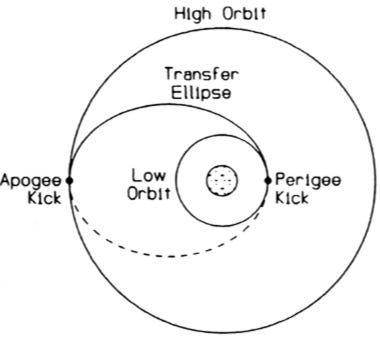
For a program that occurred in the 1960s and 1970s, before the advent of personal computers and the internet, there is no shortage of Apollo documentation available online to even the most casual of researchers. One such document succinctly describes the use of a Hohmann-type transfer for part of the lunar descent to the surface.1
“Descent orbit insertion (DOI), which is a short retrograde maneuver of approximately 75 fps performed with the descent engine, is made at a position in the orbit 180 degrees (Hohmann-type transfer) from powered descent initiation (PDI), the second descent maneuver.”
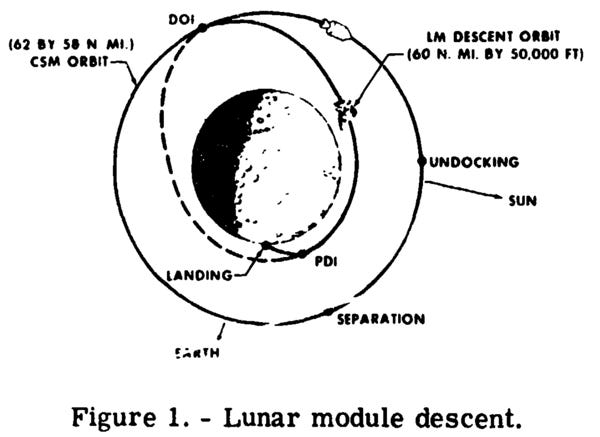
This would seem to support my belief that the LEM would be firing its engine in the direction of travel, a so-called retrograde maneuver.
If I give the artist the benefit of the doubt, I could convince myself that it might be a matter of perspective. In other words, my assumption is that the spacecraft in the illustration are traveling from left to right across the pages. If I twisted my perspective, I could imagine that they are, instead, both orbiting toward the left. This new way of looking at things would now point the engine forward so that its thrust would indeed slow the LEM. But, this still would not explain why the LEM would be angled head-down so extremely.
Here again, Pierre Mion’s National Geographic illustrations and the accompanying article may have been an influence. Mion’s depiction of the same event shows the same downward thrusting Lunar Module. The caption reads, “Firing the descent engine, they thrust LEM down toward the moon and place their craft in an elliptical orbit, with a low point only 50,000 feet from the surface.” Could the orientation of the LEM be the result of an honest misinterpretation of the phrase, “thrust LEM down toward the moon”?
Another NASA document I found might contain another clue supporting my misunderstanding theory. It contains a diagram illustrating the Descent Orbit Insertion (DOI) maneuver.2
The illustration shows the CSM and LEM, separated by some distance, at the beginning of the Descent Orbit Insertion maneuver. There is an arrow clearly indicating the direction of flight. The prominent LEM descent engine flames are, indeed, directed along the path of flight. But, the placement of the Moon’s limb in the background could make it look as if the LEM was angled head-down rather significantly.
If the National Geographic writer was under this impression, Mion may have followed his lead. And, if I am right about Mellor referencing Mion’s painting, then his illustration would carry the same LEM attitude forward into the pages of Moonshot 1970.

Now, it may actually have been the case that the LEM was pointed partially downward as depicted in both Mellor’s and Mion’s illustrations. I am afraid I was unable to find any documentation that specified the attitude of the LEM for the DOI maneuver – at least none that was understandable to me. The Apollo Flight Journal3 goes into substantial detail concerning the DOI burn specifics, but I have to admit that I am not enough of a rocket scientist to be able to decipher the information.
ADDENDUM:
A reader’s comment prompted me to dig a little deeper into the question of DOI attitude. It turns out that the Apollo Flight Journal for Apollo 104 includes a diagram that helps address this very question. It shows the events and spacecraft attitudes for the orbit leading up to the DOI burn.
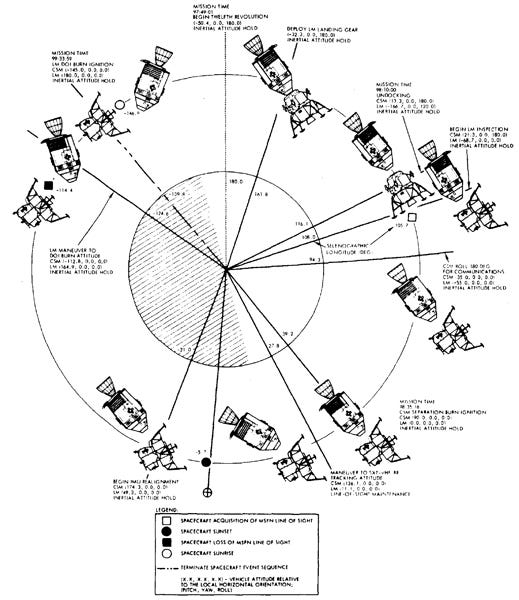
Beginning at about the one o’clock position on the diagram and working clockwise, they deploy the landing gear, undock, and spin the Lunar Module for inspection. Then the Command/Service Module puts some distance between itself and the Lunar Module to allow room for the upcoming maneuver.
At about the diagram’s 10:30 position, the Lunar Module is in position for the DOI burn. The key at the bottom of the diagram defines the meaning of the numbers following each spacecraft’s abbreviation. The ‘LM’ is shown to be at (180.0, 0.0, 0.0), meaning that relative to the local horizontal orientation (parallel to the local horizon), the Lunar Module is pitched up 180 degrees, yawed 0 degrees, and rolled 0 degrees.
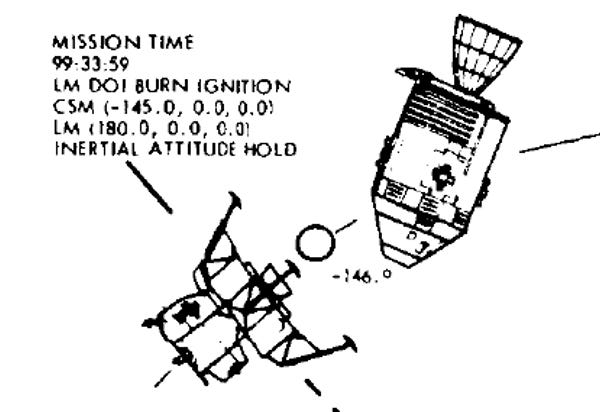
An understanding of the Lunar Module’s axis system is needed to fully decipher this bit of information. Grumman engineers chose to define the axis system such that the positive ‘X-axis’ pointed up through the top of the spacecraft. Spinning the LEM around this axis is described as ‘yaw’. Picture your head shaking ‘no’. The positive ‘Y-axis’ was defined as pointing out the right side of the LEM. Picture it coming out of your right ear. ‘Pitch’ is defined as a rotation about the ‘Y-axis’, with positive, in the case of the LEM, looking upwards.
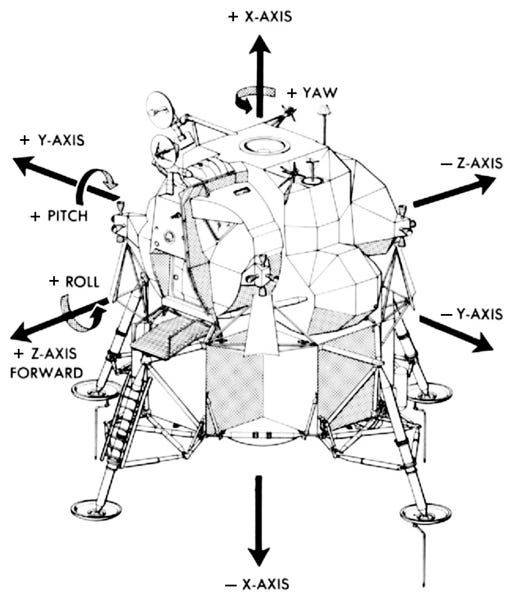
So, getting back to the DOI maneuver, a positive 180 degree pitch meant that the LEM was pitched up 180 degrees (head looking upwards and continuing back so far you are looking behind you). That results in the negative X-axis, the end with the descent engine, pointing forward along the flight path.
Congratulations! You’ve made it to the bottom of the first rabbit hole.
Rabbit Hole #2: Earth’s Orientation
Let’s now take a closer look at the Earth in this illustration. Aside from there being no clouds (which I will get to in a moment), it looked to me, at first glance, to be in the wrong place relative to the Moon. I made this judgment based on a guess that the land masses that are visible span from the southern United States southward to Central America. Take a moment to see if you agree.
If that is the case, I thought that the Earth’s southern hemisphere might be facing too far toward the Moon. I will tell you right now that I soon convinced myself otherwise, and in doing so I relearned some basic astronomical geometry that I had apparently forgotten.
Here’s how my thinking went ... see if you can catch the error:
The Moon’s orbit is inclined five degrees relative to the equator.
Therefore, as seen from the Moon, the center point of the Earth can never be more than five degrees from the equator.
This illustration looks like the center point (hidden behind the Moon) might be farther south than that.
Did you catch my error? It’s right there in the first assumption. The Moon’s orbit is not, in fact, inclined five degrees relative to the Earth’s equator. This may be common knowledge to some, but I had to refresh my flawed memory on this point. The correct statement is that the Moon’s orbit is inclined five degrees from the ecliptic plane, which is the plane traced out by Earth’s orbit around the Sun.
This diagram does a good job of illustrating the relative inclination angles of the Moon’s orbit, Earth’s ecliptic plane, and the tilt of Earth’s rotational axis. And, contrary to what I had first thought, it clearly shows that the Moon could, indeed, be positioned well below Earth’s equator at some points in its orbit – by as much as about 28 degrees, in fact.

With this established knowledge newly reentered into my brain’s astronomical database, I decided to confirm the illustration’s rendition of the Earth.
I took out my trusty world globe to see if I could recreate the view in Moonshot’s illustration.
Sure enough, the view closely matches what you would see if you were orbiting above about 14 degrees south latitude (marked by the globe’s center point), which is well within the 28 degree extreme.
Congratulations, Moonshot! You continue to impart learning in people even to this day.
Rabbit Hole #3: Cloudless Earth
I noted above that the Earth is shown without any clouds. This was often seen in renderings of the time. I find this trend interesting since the first images of the Earth from space clearly showed cloud formations. They were captured in 1946 high above White Sands, New Mexico, from a camera mounted to a captured German V2 rocket.

Even if one might argue that such photos were not widely available in pre-internet days, by the early to middle 1960s there would have been countless color photos of Earth from the early Mercury and Gemini space missions published in popular magazines. Surely, artists would have had access to some of those to use as references.
Earthlight
Moving on to the next illustration in the book, we find a view of an astronaut descending from the LEM. It highlights the blue “earthlight” that was expected to be cast from the reflected sunlight off our planet. To my knowledge, none of the Apollo astronauts made any mentioned of such a phenomenon, and it doesn’t show up in any photographs taken on the surface. Where it might have been visible would likely be from the orbiting Command Module while it was on the shaded side of the Moon while still in view of Earth. If anyone reading this has access to an astronaut who has seen the Moon up close first-hand, this would be an interesting question for them.
Bound to Explore
Spanning the next two pages is a very nice illustration depicting the LEM resting on the lunar surface after landing. One astronaut has exited the LEM to explore, bounding over the lunar landscape in the reduced gravity, while the second has remained inside observing from his window.
The same illustration is used on the front and back covers of the book, but mirrored (except for the “United States” text and the flag). I suspect the orientation on these two interior pages are as originally drawn, and the image was flipped on the cover to place the LEM on the front of the book.
Eagle-eyed readers might have noticed that the LEM on the previous (“Earthlight”) page shows the ladder and rope on the opposite side compared to this two-page spread. The placement of the ladder, rope, and its support structure can offer a clue as to which orientation is correct. As I noted in my previous post, the reference for these features likely came from a Grumman factory mockup called TM-1 used for astronaut mobility and egress/ingress tests in March of 1964. On that mockup, the ladder and rope were positioned on the LEM’s port (left) side. That position is correctly portrayed on this page. A couple of pages ahead in the book, the lunar liftoff illustration has these features switched back to the opposite side, again.
From an artist’s point of view, swapping the placement of features might be desirable in order to make things clear to the viewer. From an engineer’s perspective, this might induce some dizziness.
The Men in the White Coats
Remember when I said there may be men in white coats? Well, here they come!
One of the early concepts for the space suits the Apollo astronauts would wear in the harsh environment of the lunar surface included a thermal overgarment, or a set of coveralls, consisting of a hooded parka, overpants, boot covers, and mittens. These would be worn over the pressurized space suit, providing protection from the blazing sunlight. The overgarment is depicted in this book on several of its pages. Additionally, a “meteoroid cape”, as it is referred to in the book, was considered for wearing over the thermal garment for protection from micrometeoroids.5 Both of these concepts were eventually dropped in favor of integrating multiple protective layers of material and fabric onto the pressurized suit, itself.
Here, also, we see an early rendition of the portable life support system (PLSS) backpack. It is shown without any protective covering. The Apollo PLSS, as used, had a white protective covering of its own. It also included hoses that supplied breathing oxygen and communication cables, among other things.
I love being able to find photographs that were used as references by artists and matching them to their illustrations. This one clearly served as the model for the illustration on this page. It shows two astronauts demonstrating the prototype thermal overgarments in 1964.
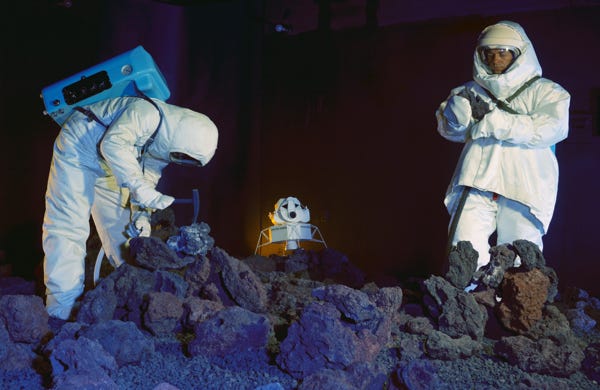
I was able to find two examples of this photo online. There is conflicting information about who the astronauts are. I am tempted to trust the one in the Space News Roundup newsletter from the Manned Spacecraft Center in Houston, Texas. The caption printed beneath the photo says the astronauts are Frank Borman and Elliot See. Neither one would have the opportunity to use their space suits on the Moon’s surface, yet here they are, just a few months after the first unmanned Gemini mission, helping evaluate key components and procedures for the upcoming Apollo program.
Lunar Liftoff
After exploring the lunar surface it is time to blast off in our Lunar Module’s ascent stage and rejoin our third crew member in the Command Module, which has remained in orbit around the Moon for the duration of our stay.
Once again, we can trace a possible reference for this illustration back to Pierre Mion. But, this time there is a twist. Mion’s National Geographic depiction of the lunar liftoff uses a different composition than the one in Moonshot 1970.
Mion created another lunar liftoff painting for LOOK magazine a couple of years after this one. There is a very entertaining story written by Pierre, published in Smithsonian Air & Space magazine in 2006.6 Pierre describes the time he was called on the phone by renowned artist Norman Rockwell and didn’t believe it was him, at first. After the confusion was cleared up, Norman asked Pierre if he would assist him on a set of paintings he was doing for LOOK magazine. Pierre ended up doing more than assisting and painted the lunar takeoff entirely himself.
I would say that Mion’s LOOK magazine painting may have been the model used for Mellor’s Moonshot illustration, but the first publication date that I know of for Mion’s lunar liftoff was the 1968 special edition covering the flight of Apollo 8 ... after Moonshot 1970 was published.
A final guess as to the reference Mellor may have used is this lunar liftoff illustration by Los Angeles Times artist, Russel Arasmith. My source for this image states no date for its publication. But, judging by the look of the Lunar Module, I think it is plausible that it could have been created at about the same time frame as Moonshot 1970.
Coming Home
At this point in the book, the illustration style switches back to more simplified depictions, just as we saw on the beginning pages. We are taken through a fiery reentry and into a gentle splashdown under the red and white parachutes. (or, if you are to believe the picture instead of the words, a single parachute).
As our great adventure concludes, the author leaves us with that ever-optimistic closing seen so often in these children’s books ...
“We’ve been to the moon and we’ll go again! Someday we’ll go to the planets, and from the planets – to the stars.”
Let’s Get Technical (Again)
The next two pages contain technical references for the Saturn V rocket, lunar backpack, and Moon suit. There are five key facts about the Moon, itself, which presumably every young space explorer should be familiar with. And, there is a very brief glossary of “space speak” which includes two tools that I challenge anyone to find at their local hardware store – a “plench” which is a combination of pliers and a wrench, and a “spammer” which, contrary to the modern definition, is simply a space hammer specially made for use in the spacecraft cabin. Interestingly, the author chose to include the word “scrub” in the short four-word list. So much for optimism, I guess.
We’re not done, yet, though. If we are truly going to the planets, we had better bring along a map. Call me nostalgic, but it still warms my heart to see Pluto included in our solar family.
The book concludes with a short group of participatory science experiments. Fittingly to one of the rabbit holes I went down, there is an exercise meant to teach the non-intuitive complexities of sending a spacecraft from one orbiting body to another. The second lesson suggests the use of a string tied around a baseball to get a feel for orbital physics. Unfortunately, the logic falls a little short with their suggestion that the power required to launch a rocket is somehow related to that needed to stay in orbit. (Kids, in case you are reading this, you do need more rocket power to get to a higher orbit, but once there you can stay there indefinitely without any more engine burns, provided you are above any drag-producing air molecules. That’s why the International Space Station can stay in orbit without any engines.) The third lesson employs a balloon and milk carton to build an air boat to teach about action and reaction forces.
And with that, you are well equipped with the knowledge needed to follow along with the upcoming Apollo flights, and to be inspired to continue your education, grow up, and participate in any number of ways in the space future, ahead.
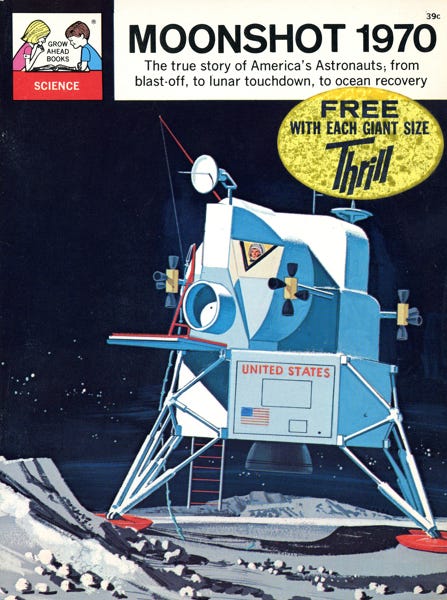
Merch of the Month
Moonshot 1970: Moments to Touchdown Giclée Print
Moonshot 1970: Moments to Touchdown is a reimagining in 3D of the cover illustration on the 1967 book "Moonshot 1970". Written by Martha Lomask, illustrated by Gordon Mellor. The Apollo Lunar Excursion Module (LEM) is moments from touching down on its landing spot, illuminated in part by the soft blue Earthlight.
About Giclée Prints
Open edition giclée prints of select images are custom ordered for you by the artist. Open editions are an affordable way to enjoy uniquely styled art while giving you the option of enhancing the look of your home with your own display frame. Made with high-quality archival inks on fine art papers.
Prints of select images are custom ordered for you by the artist. Professionally produced by a leading photographic printing lab in the United States. Framing suggestions and room decorations are not included.
FREE SHIPPING ON ALL ORDERS WITHIN THE U.S. (Excluding Zazzle products.)
(NOTE: I currently ship exclusively to the U.S.)
SOCIAL IMPACT
Your purchase from Pixel Planet Pictures helps support and promote space-related STEAM organizations and initiatives that enable and inspire students and youth to learn, develop, and pursue passions in science, technology, engineering, arts, and math.
Don’t forget to use your discount code, below, for 15% off.
A special offer for readers of Creating Space ...
As a special thank-you for reading Creating Space, I am offering a discount on my artwork.
Simply use code CREATINGSPACE15% for 15% off your entire order from the Pixel Planet Pictures shop.
My space-inspired art portfolio can be found at pixel-planet-pictures.com. You can also follow me on Instagram (pixelplanetpics).
Do you know fellow Space Geeks who might enjoy Creating Space? Invite them into this space, too!
Did you miss a post? Catch up here.
If you enjoyed this article please hit the ‘Like’ button and feel free to comment.
All images and text copyright © Dave Ginsberg, unless otherwise noted. All rights reserved.
Apollo Lunar Descent and Ascent Trajectories, NASA TM X-58040, Floyd Bennett, Manned Spacecraft Center, Houston, Texas, March 1970
Mission Operation Report M-932-69-11, Apollo 11 (AS-506) Mission, Office of Manned Spaceflight, Apollo Program Office – MAO, June 24, 1969
Apollo Flight Journal, Apollo 11, Day 5, part 2: Undocking and the Descent Orbit
Apollo Flight Journal, Apollo 10, Day 5, part 18: Undocking & DOI, Snoopy goes solo
Space News Roundup!, Manned Spacecraft Center, Houston, Texas, Vol. 3, No. 21, p. 3. August 5, 1964
Norman Rockwell’s Ghost, Smithsonian Air & Space magazine, Pierre Mion, September 2006


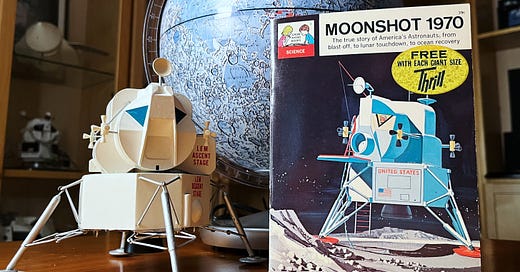


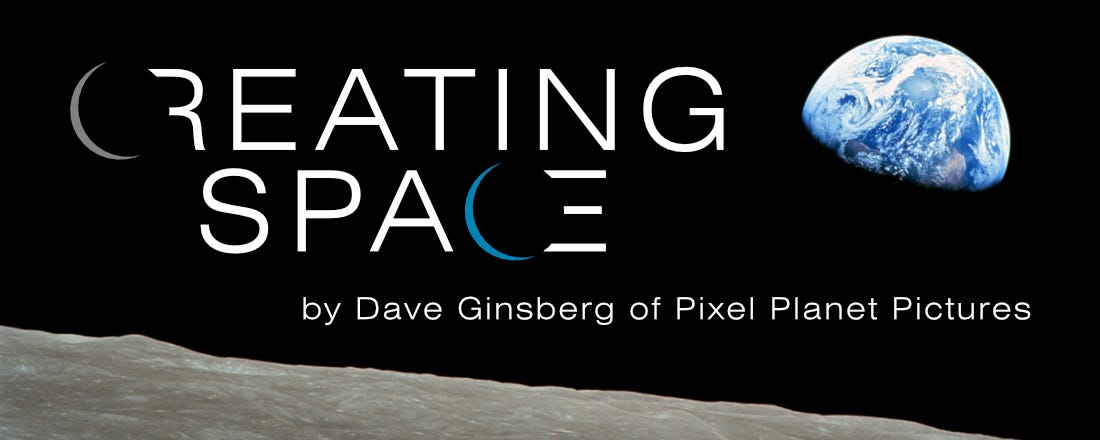

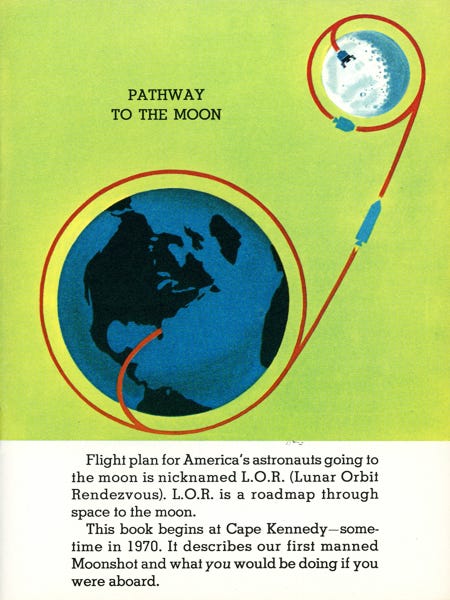



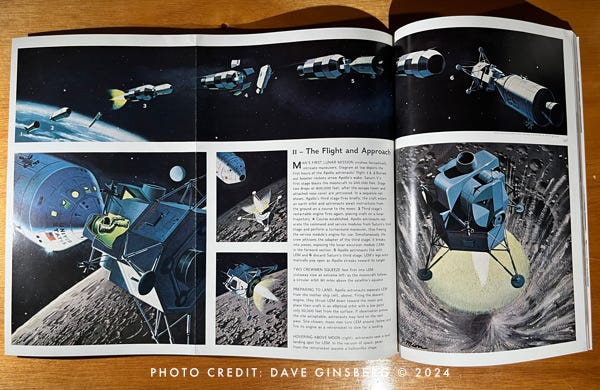
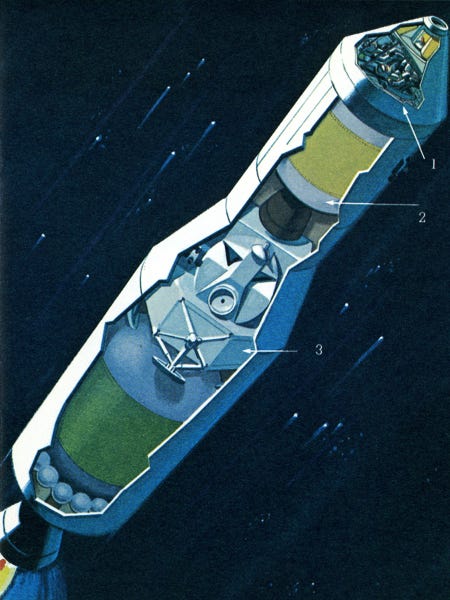
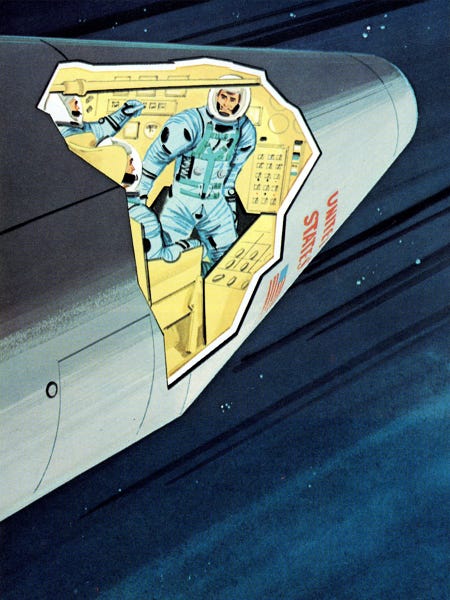

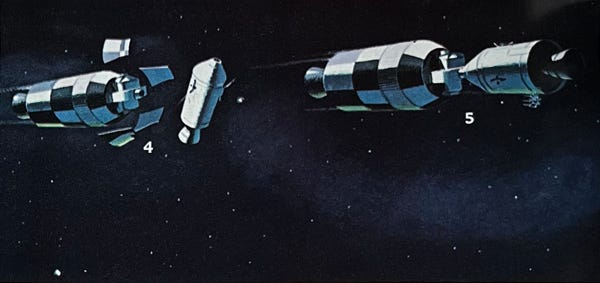
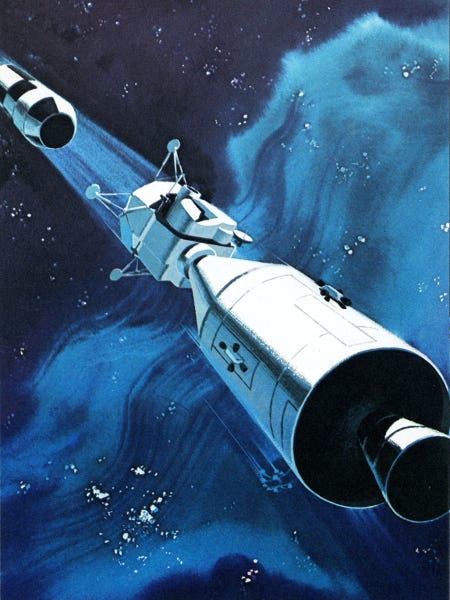


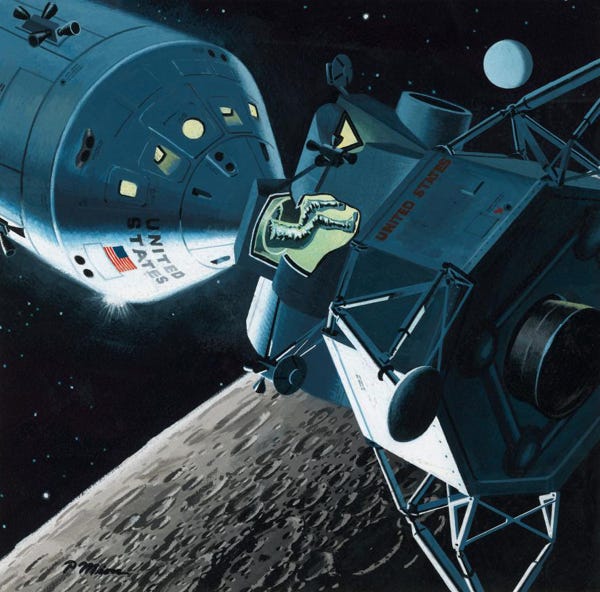


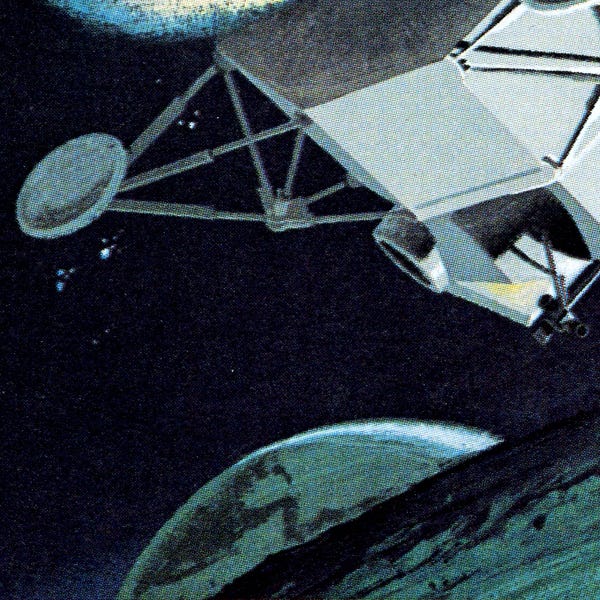
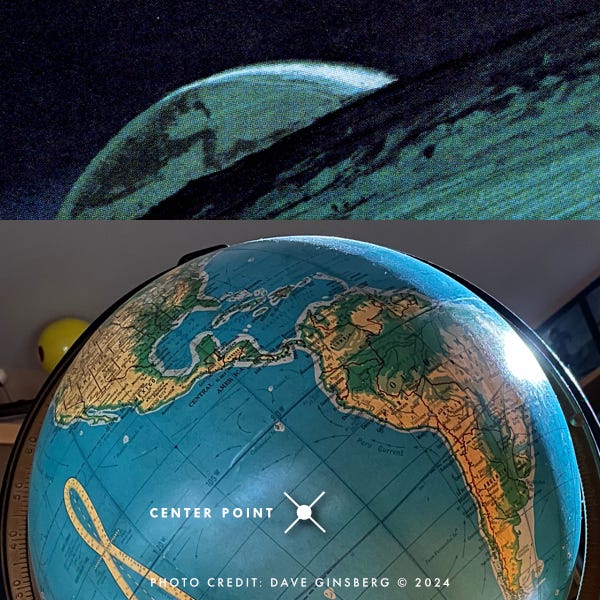
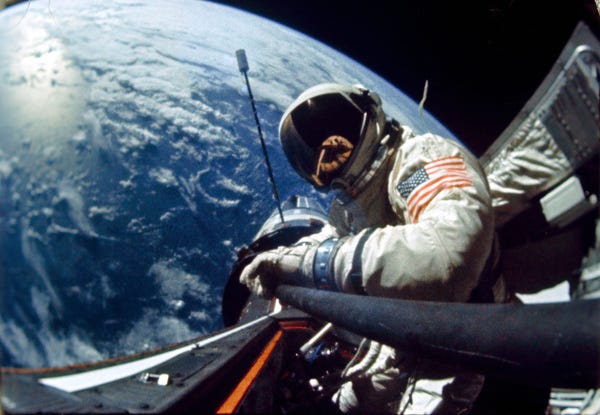

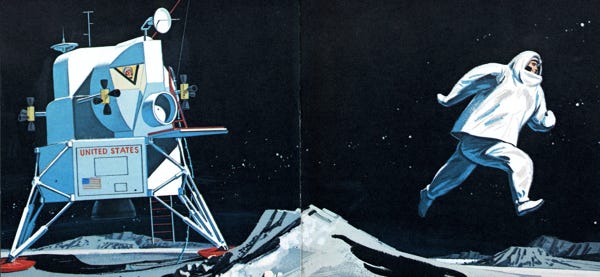
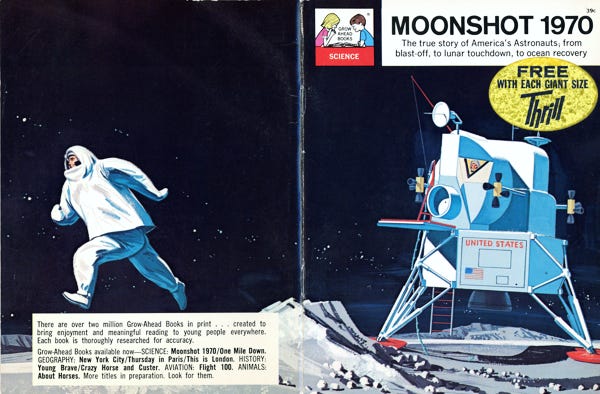





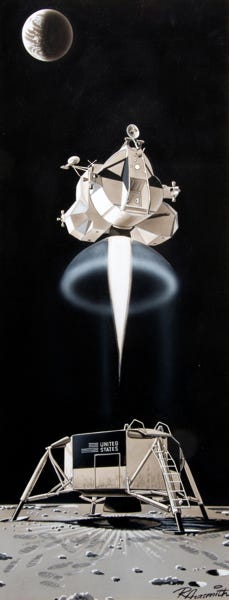
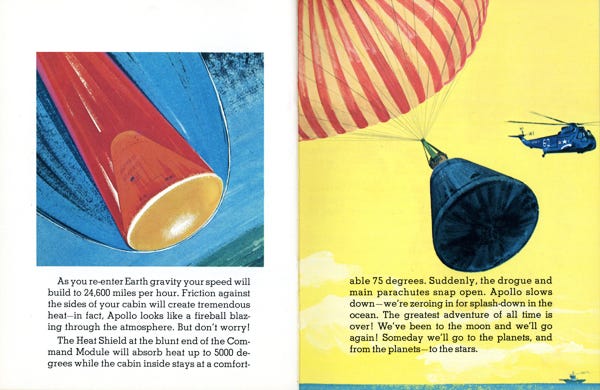

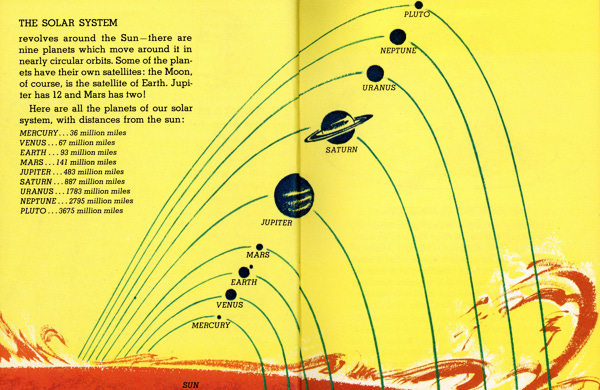
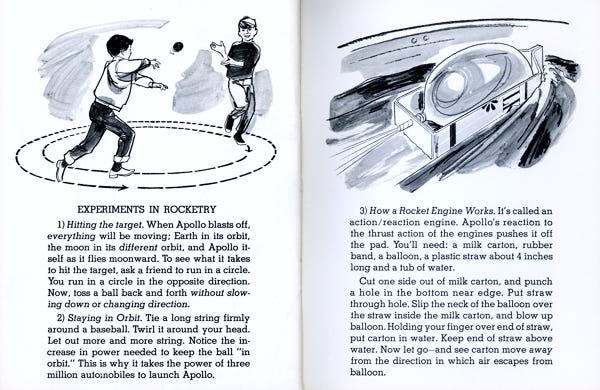

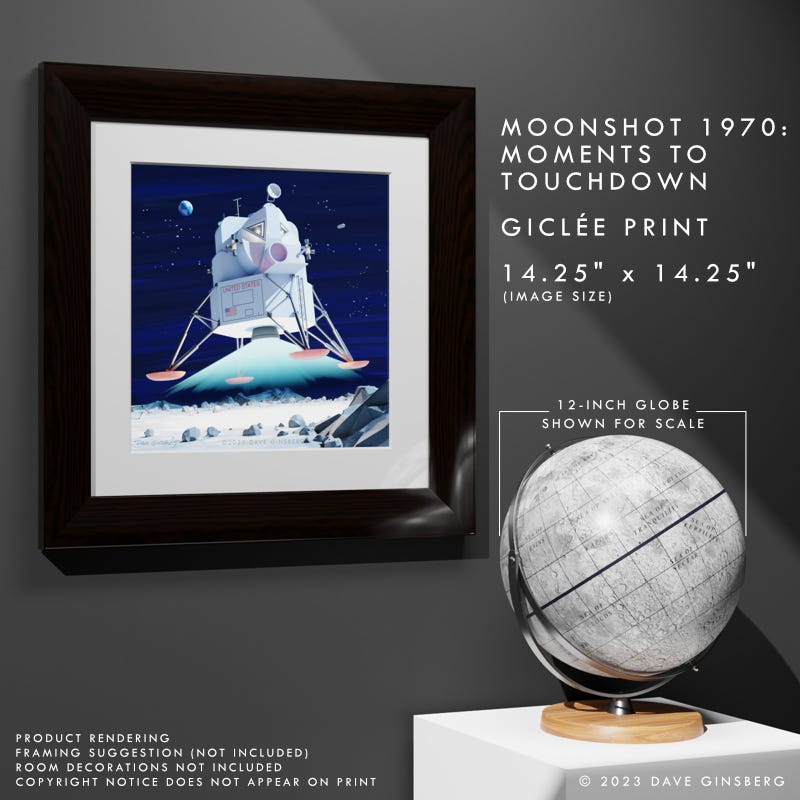






David -
Once again you have discovered and published a fascinating look at an edge of space I knew nothing about. The link to Mion's meeting with Rockwell was a fun read as well.
Like you I loved the coverage of this in the 60s. I was young but totally enthralled and still have a pack my mum & dad bought me: one of the few items of memorabilia that I cherish.